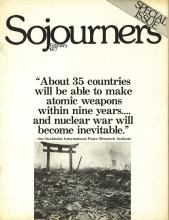I was two months old when my country killed at least 150,000 people in Japan with the atomic bomb. Today, more than three decades later, I have been reading for the first time the personal accounts of those who remember seeing the flash of that bomb, and feeling its pain sear their skin. Looking at the pictures of countless scorched and wasted corpses, my mind flashed back to similar images at the Dachau Memorial Museum and prison camp in Germany seen 13 years ago when my brother and I visited there. Taking out the journal kept during that European trip, I read, “It’s hard to believe that men would actually resort to treating other people in such ways and feel justified about it.”
Like most living Americans, I grew up knowing of the bomb more as a justifiable and heroic memory than as current reality. I was taught with pride that we were the first to invent the bomb. Its explosion over Hiroshima and Nagasaki ended the war, and saved American lives. The single most brutal murderous act of modern warfare was glorified with rhetoric about peace and life.
The Japanese who remember that day speak of being in hell. Futuba Kitayama, then a 33 year old housewife, wrote, “Under the bridge were floating, like dead dogs or cats, many corpses, barely covered by tattered clothes. In the shallow water near the bank, a woman was lying face upward, her breasts torn away and blood spurting. A horrifying scene. How in the world could such a cruel thing happen? I wondered if the hell that my grand-mother had told me so much about in my childhood had fallen upon the earth.”
We do not find in American history books such vivid accounts of the mass horror which descended upon the people of these cities. Such memories are repressed. A whole generation of Americans has grown up thinking of the bomb as something in our past, rather than in our present and our future. To us, the bomb seems strangely remote, intangible, hypothetical, almost other-worldly.
Read the Full Article

